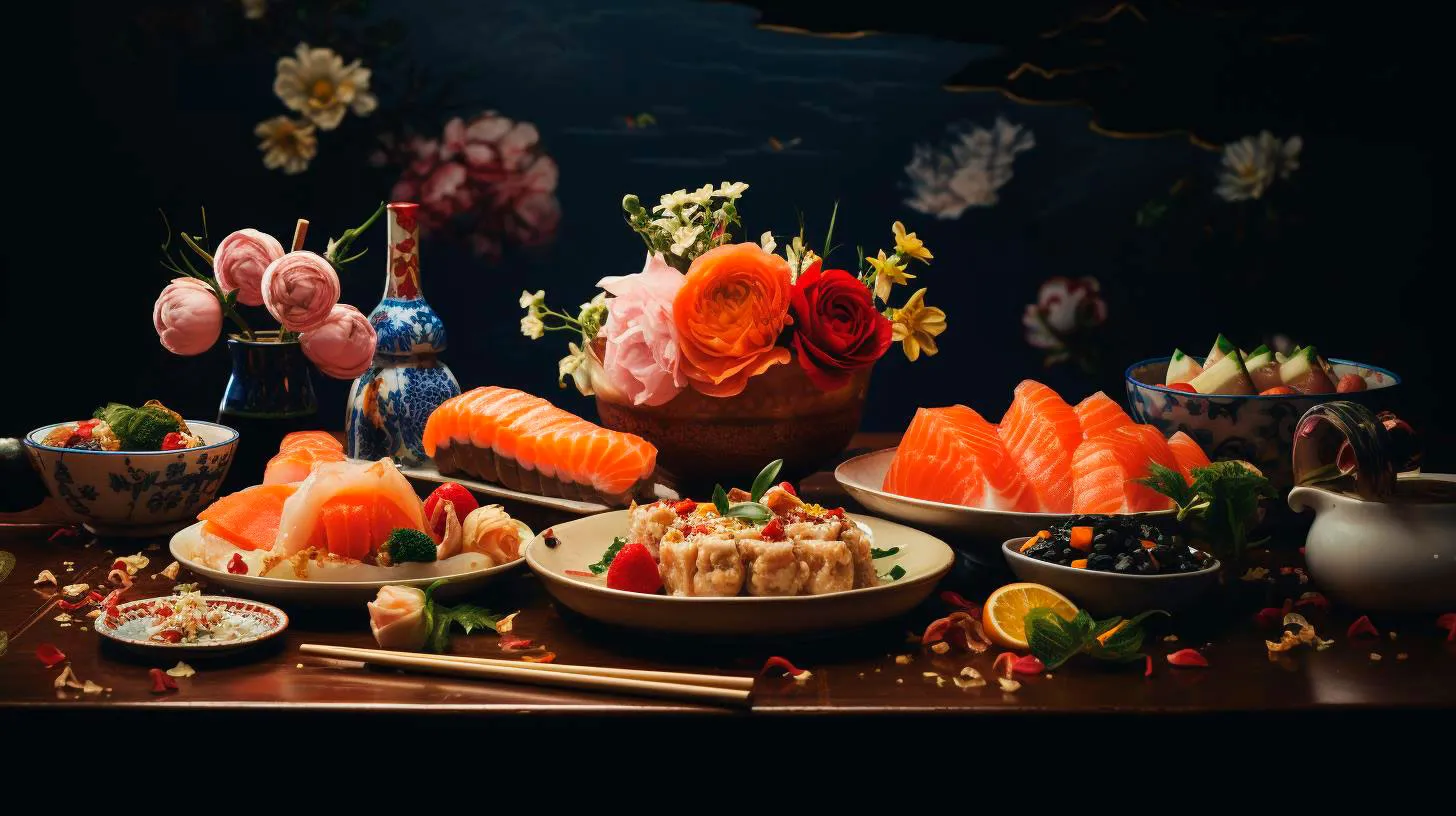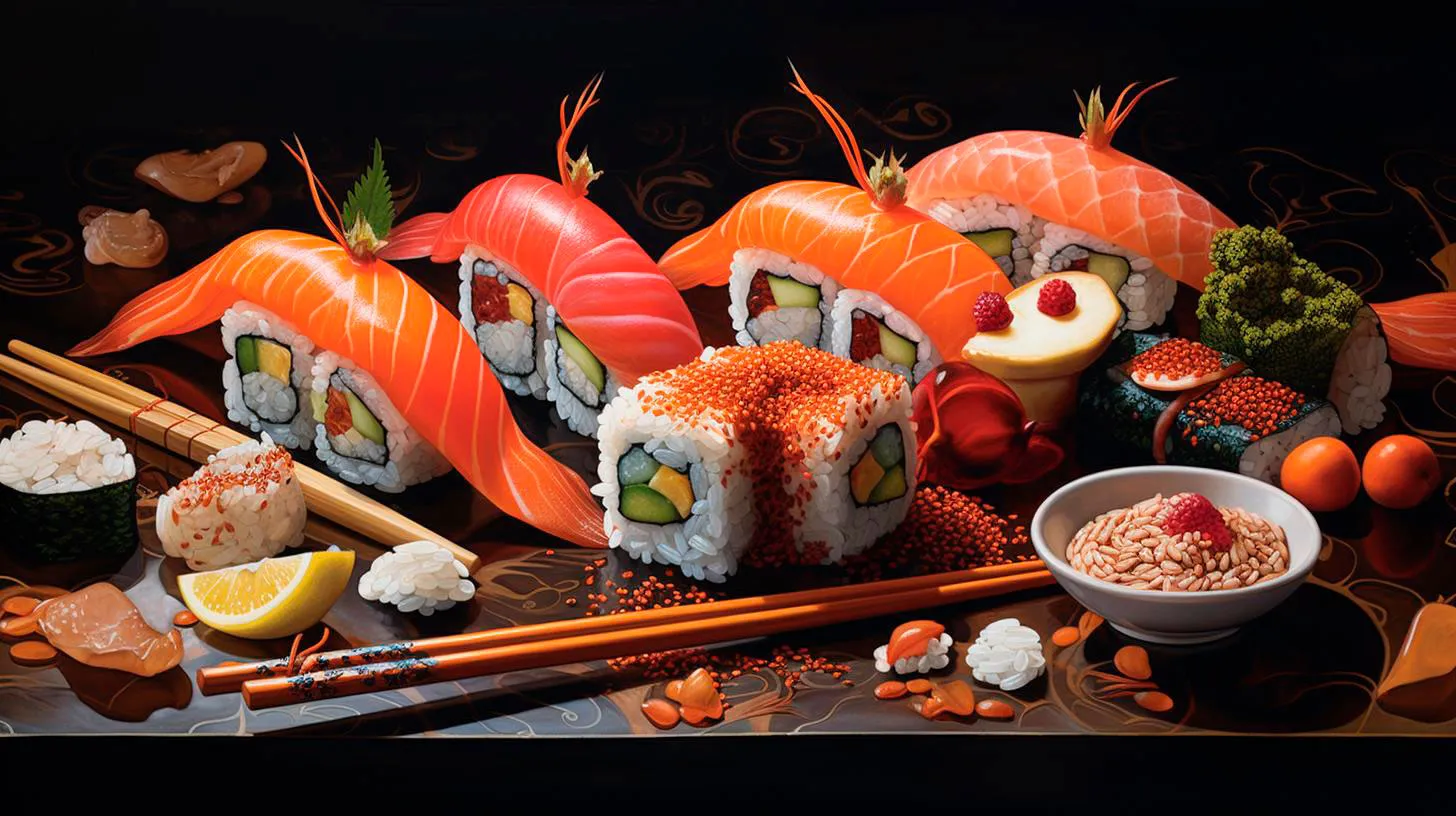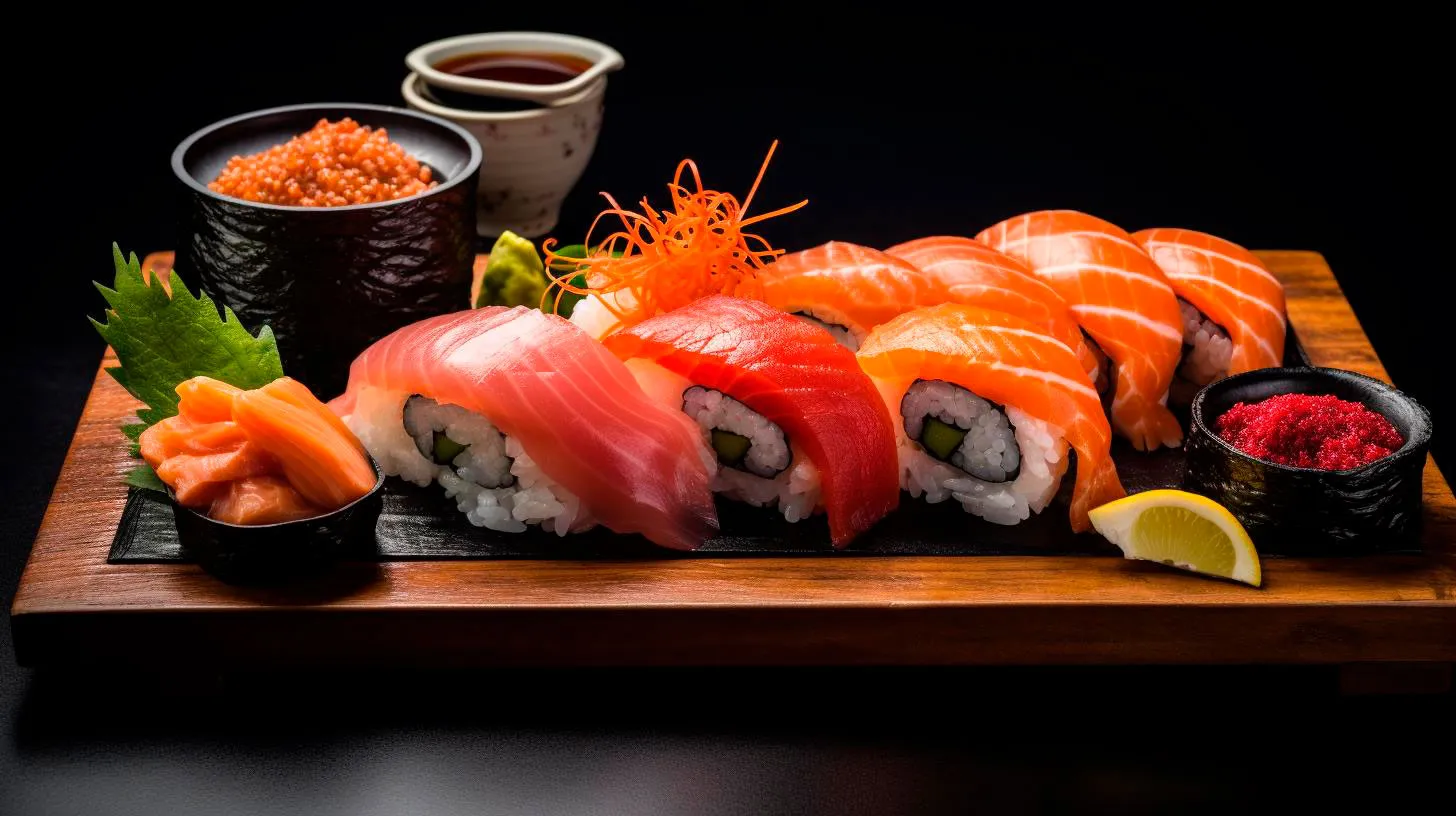The Origins of Sushi: A Culinary Classic Spanning Borders
In this article, we delve into the fascinating history of sushi, exploring its beginnings, transformation, and its current status as a culinary classic.
The Birth of Sushi
The origins of sushi can be traced back to ancient Japan, where it was initially developed as a method to preserve fish. In the 4th century, the technique called narezushi emerged, where fish was fermented with salt and rice, creating a tangy and pungent flavor. The fermented rice was discarded, and the preserved fish was consumed. This early version of sushi laid the foundation for what would later become a revolutionary culinary creation.
Evolution of Sushi
It was during the Edo period in the 19th century when sushi underwent a significant transformation. Edo-mae sushi was born, and it marked a departure from the fermentation process. The introduction of vinegar-infused rice allowed for a much shorter preservation time, rendering sushi fresh and ready to eat almost immediately. This innovation revolutionized the world of sushi and set the stage for its rapid popularity and global expansion in the years to come.
As sushi became more ubiquitous and accessible, different variations and styles emerged, catering to diverse palates and cultural preferences. Here are some sushi styles that gained worldwide recognition:
- Nigiri: One of the most recognized sushi types, nigiri is a small hand-pressed mound of rice topped with various ingredients like fresh fish, seafood, or vegetarian options. It showcases simplicity and allows the flavors to shine.
- Maki: Maki rolls, also known as sushi rolls, consist of rice, fish, and vegetables wrapped in nori (seaweed). They are often sliced into bite-sized pieces, making them a popular choice in sushi restaurants.
- Sashimi: While not technically sushi, sashimi is a dish that showcases thinly sliced, raw fish or seafood, served without rice. It highlights the natural flavors of the fish and demonstrates the skill of the chef.
Sushi Goes Global
With its aesthetically pleasing presentation and an explosion of flavors, sushi quickly garnered international attention. In the mid-20th century, sushi chefs from Japan began to venture beyond their homeland, bringing this iconic culinary art form to different parts of the world. Soon, sushi found its way onto the menus of restaurants in major cities across the globe.
The globalization of sushi led to a fusion of traditional and contemporary elements, resulting in unique and innovative sushi creations that catered to local tastes. This fusion has given rise to popular varieties such as:
- California Roll: Invented in Los Angeles, the California roll combines avocado, crab meat, and cucumber, wrapped in nori and rice. It played a pivotal role in introducing sushi to Western palates.
- Tempura Roll: This sushi roll is filled with tempura-battered and deep-fried ingredients, providing a crunchy texture that adds a delightful twist to the traditional sushi experience.
- Sushi Burrito: A creative take on sushi, the sushi burrito combines the concept of a burrito with sushi fillings, offering a convenient and portable option for sushi lovers on the go.
The Health Benefits of Sushi
Beyond its incredible taste and cultural significance, sushi also offers numerous health benefits. Here are some key takeaways:
- Omega-3 Fatty Acids: Sushi made with fatty fish like salmon or tuna provides a healthy dose of omega-3 fatty acids, which are known for their heart-healthy properties.
- Low in Calories: Sushi rolls are generally low in calories, especially when compared to other fast food options. This makes it an excellent choice for those looking to maintain a balanced diet.
- Rich in Minerals: Sushi often incorporates ingredients like seaweed, which is packed with minerals like iodine, magnesium, and calcium, promoting overall health and well-being.
The Enduring Legacy of Sushi
Today, sushi continues to evolve and captivate food enthusiasts worldwide. Its rich history, versatile nature, and unique flavors have cemented sushi’s place as a culinary classic. Whether enjoyed traditionally or with a modern twist, sushi’s ability to unite cultures through a shared love for exquisite cuisine showcases its timeless appeal. So, next time you savor every bite of a meticulously crafted sushi roll, remember the incredible journey this culinary masterpiece has undertaken to arrive on your plate.
Sushi Through the Centuries: A Glimpse into its Evolution
In this article, we’ll explore the fascinating journey of sushi and how it has transformed over time.
The Origins: Ancient Fermented Fish
Believe it or not, the origins of sushi can be traced back to 2nd century China. During this period, people began fermenting fish with rice, a process that preserved the fish and transformed its taste. This method eventually made its way to Japan, where it evolved into a unique culinary tradition.
Key takeaways:
- Sushi originated from fermenting fish with rice in ancient China.
- It was introduced to Japan and adapted into a distinct culinary practice.
The Birth of Nigiri: Simplicity at its Best
Fast forward to the 19th century, and we see the birth of nigiri sushi. Chef Hanaya Yohei, a renowned sushi chef in Edo (now Tokyo), is credited with revolutionizing sushi. He combined fresh fish with vinegared rice, forming a bite-sized delicacy that became an instant hit.
Advantages of nigiri sushi:
- Offers a delightful blend of flavors with minimal ingredients.
- Emphasizes the natural taste and texture of the fish.
- Provides a visually appealing presentation.
Sushi Goes Global: The Makings of a Worldwide Sensation
As Japan opened its doors to the rest of the world in the 20th century, sushi gained international popularity. Sushi chefs started experimenting with different ingredients and styles to cater to diverse palates. This led to the creation of rolls, such as the famous California roll, which introduced avocado and crab meat as ingredients.
Key takeaways:
- Sushi became a global phenomenon in the 20th century.
- The introduction of rolls expanded the variety of sushi.
- Integration of local ingredients and flavors made sushi adaptable to different cultures.
Modern Innovations: Fusion and Beyond
With sushi firmly established worldwide, chefs continue to innovate and push boundaries. The concept of fusion sushi emerged, blending traditional Japanese techniques with ingredients from other cuisines. This led to the creation of unique rolls, such as the spicy tuna roll, which combines spicy mayonnaise with fresh fish.
Advantages of modern sushi innovations:
- Allows for the exploration of flavors from different culinary traditions.
- Encourages creativity and experimentation among sushi chefs.
- Offers an exciting and diverse dining experience for sushi enthusiasts.
Statistics:
- During the last decade, sushi consumption in the United States alone has increased by 50%. (Source: USA Today)
- Sushi restaurants in Japan earn an estimated $17 billion annually. (Source: The Japan Times)
The Future of Sushi: Sustainability and New Culinary Frontiers
Looking ahead, sustainability is a key concern within the sushi industry. With overfishing and declining fish stocks, sushi chefs and suppliers are turning towards more sustainable seafood options, such as farm-raised fish and plant-based alternatives.
Key takeaways:
- Sustainable practices are becoming increasingly important in the sushi industry.
- Adoption of alternative ingredients ensures the longevity of sushi as a culinary tradition.
- The future of sushi lies in exploring new culinary frontiers while preserving its essence.
In Conclusion
Sushi has come a long way from its humble origins in ancient China. From the simplicity of nigiri to the global popularity of rolls and fusion creations, sushi continues to captivate taste buds and push culinary boundaries. With a focus on sustainability, the evolution of sushi promises exciting and delicious innovations for generations to come.
Sushi Fusion: Exploring Inventive Variations from Around the World
Discover the exciting journey of sushi fusion and explore the mouthwatering combinations that have gained popularity worldwide.
The Evolution of Sushi Fusion
Sushi, originally a Japanese delicacy, has transcended cultural boundaries and embraced the influence of international cuisines. Sushi fusion emerged as a result of creative chefs experimenting with innovative ingredients and techniques. By combining traditional sushi elements with unconventional flavors and cooking methods, these culinary visionaries have revolutionized the way we perceive and enjoy sushi.
- Japanese-Peruvian Fusion: One popular sushi fusion trend is the marriage of Japanese and Peruvian cuisines, also known as Nikkei. This unique blend features vibrant flavors, such as the use of tangy citrus-based sauces like yuzu kosho and aji amarillo.
- Hawaiian Fusion: Hawaii’s diverse culinary landscape has greatly influenced sushi fusion. The introduction of Hawaiian ingredients like pineapple, mango, and macadamia nuts adds a tropical twist to traditional sushi rolls, creating a refreshing and adventurous dining experience.
- Mexican Fusion: Sushi with a Mexican flair is another exciting fusion trend that has gained significant popularity. Think sushi rolls infused with chipotle mayo, jalapeños, or even guacamole, providing a spicy kick and a delightful fusion of flavors.
The Advantages of Sushi Fusion
Sushi fusion not only expands the range of flavors and textures but also appeals to a broader audience. By incorporating ingredients and flavors from different cultures, sushi fusion creates a more inclusive dining experience, enticing those who may not traditionally be sushi enthusiasts. This fusion allows for greater creativity, as chefs have the freedom to experiment and develop unique flavor combinations that tantalize the taste buds.
Furthermore, sushi fusion has given rise to a world of possibilities, providing options for those with dietary restrictions or preferences. Vegetarian and vegan sushi rolls have become increasingly popular, featuring innovative ingredients like tofu, avocado, and various vegetables. These plant-based variations cater to a growing demand for sustainable and ethical food choices.
Key Takeaways
Sushi fusion has taken the culinary world by storm, offering endless possibilities and flavor combinations. Here are some key takeaways:
- Sushi fusion combines traditional Japanese sushi with flavors and ingredients from various cuisines.
- International influences, such as Japanese-Peruvian, Hawaiian, and Mexican, have contributed to the rise of sushi fusion.
- Sushi fusion appeals to a wider range of palates and accommodates dietary restrictions, including vegetarian and vegan options.
- It allows chefs to explore and experiment with unique flavor combinations, creating an exciting and innovative dining experience.
According to recent statistics, the global sushi market is expected to reach a value of $27.5 billion by 2025. The popularity of sushi fusion plays a significant role in driving this growth, as more people embrace the rich diversity of flavors and ingredients that sushi fusion offers.
In conclusion, sushi fusion is a culinary journey that encompasses the best of multiple cultures. By blending traditional sushi elements with innovative flavors, sushi fusion represents a celebration of global gastronomy. So, venture out of your comfort zone and explore the inventive variations of sushi fusion from around the world – your taste buds will thank you!
Sushi Etiquette: Unveiling the Cultural Customs Behind this Artful Dish
However, enjoying sushi is not just about the taste, but also understanding the etiquette that comes with it.
The Art of Sushi
Sushi is more than just raw fish rolled into bite-sized pieces. It is a balance of flavors, textures, and aesthetics that harmonize to create a culinary masterpiece. To truly appreciate sushi, one must understand the essential elements:
- Sashimi-grade Fish: The quality of the fish used is of utmost importance. Freshness, texture, and taste are key factors that sushi chefs consider when selecting fish.
- Sushi Rice: What sets sushi apart is the vinegared rice. Its sticky texture and subtle flavor perfectly complement the toppings.
- Nori: The dried seaweed used to hold the ingredients together adds a pleasant mineral taste and provides a satisfying crunch.
- Wasabi and Soy Sauce: These condiments are essential for adding extra flavor to your sushi. However, it is important not to overdo it and overpower the delicate flavors of the dish.
Understanding Sushi Etiquette
While enjoying sushi, it is crucial to follow the cultural customs associated with this culinary art. By adhering to these etiquettes, you not only show respect for the chef and the cuisine but also enhance your overall dining experience. Here are some key points to consider:
1. Eating with Chopsticks or Hands
When it comes to sushi, there are no strict rules on how to eat it. Traditionally, sushi is consumed using chopsticks, but it is also acceptable to eat with your hands if you prefer. However, keep in mind that using chopsticks demonstrates a level of skill and appreciation for the craft.
2. Dipping and Soy Sauce Usage
When dipping sushi in soy sauce, avoid dunking the rice. Instead, lightly dip the fish-side to ensure the balance of flavors is maintained. If you want to add wasabi, a small dab can be placed directly on top of the fish. Remember, less is more, as the sushi chef has already expertly seasoned the sushi.
3. One-Bite Delight
Sushi is typically served as a single bite. Devouring it in one bite allows for an explosion of flavors and textures to be experienced all at once. Avoid taking multiple bites or dissecting the piece, as this disrupts the intended harmony of the dish.
4. Order of Consumption
When served a variety of sushi, it is customary to begin with lighter flavors and progress towards richer, more flavorful options. This progression allows you to fully appreciate the subtleties of each piece and prevents overpowering your palate with strong flavors.
Key Takeaways:
- Appreciate the artistry behind sushi, from the selection of fresh fish to the vinegared rice.
- Understand the cultural significance and customs associated with sushi.
- Enjoy sushi with chopsticks or hands, but show skill and respect with chopsticks if possible.
- Dip sushi lightly in soy sauce, avoiding the rice, to maintain the balance of flavors.
- Consume each piece in one bite to fully experience the flavors and textures.
- Follow the traditional progression of flavors from lighter to richer options when offered a variety of sushi.
By embracing these sushi etiquette guidelines, you not only enhance your own dining experience but also demonstrate respect for the cultural customs intertwined with this ancient culinary art. So next time you savor a piece of sushi, remember that it is not just a meal but a cultural experience that has been perfected over centuries.



